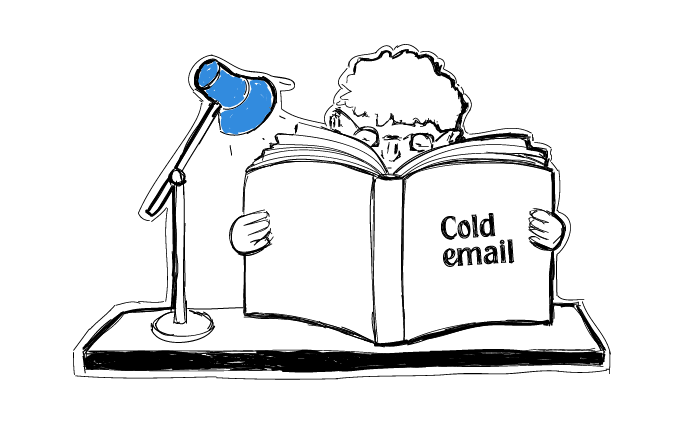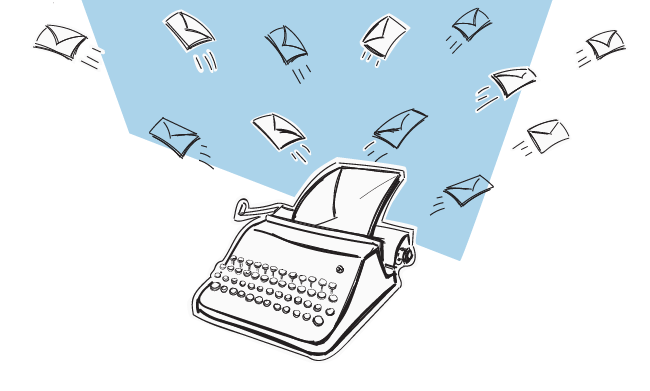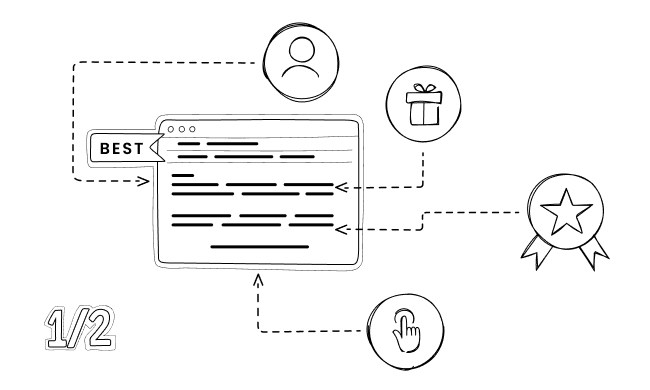This is the blog post you’ve been waiting for… trust me.
I asked four people from the Woodpecker team about the best cold email they ever got, and ran an in-depth analysis of their subject lines, email body and CTA.
You’ll learn how to write a first-class cold email that’ll sweep your prospects off their feet… or chairs.
This is part one, in which I break down the first two cold email examples.
Example #1: the best cold email Agata ever got
Congratulations on your new position as Head of Product Marketing, Agata! I hope when you read this email you don’t think, “this cold email sucks, he should have used Woodpecker”. The reason for my email is because we host daily events for sales and sales leaders, and Woodpecker seemed like the perfect fit to get in front of our audience. Let me know if you’d like to look at our event schedule and sponsorship opportunities. SalesLoft, Gong, Salesforce and Chillipiper get 30k sales professional leads each month from sponsoring our daily events. If you’re not opposed to chatting, I think we could have a pretty good conversation.
Why Agata thinks this is the best cold email she has ever received:
“It’s the only cold email in probably a year where there was personalization (seriously!), and it’s accurate. The first sentence showed up in my inbox preview and got me curious enough to open it and read it.”
Let’s analyze:
- ‘Subject line: {Their company name} <>Woodpecker’
Yup… you’ve probably seen a version of this subject line before, haven’t you?
Opinions on popular subject lines, like the one used in this cold email example, are divided. If prospects see them regularly, they might be less likely to open the email.
But the truth is – it all comes down to who you’re writing to. We’ve seen it work well for some, for others – not so much. So it’s definitely worth running an A/B test to see if it works for you.
- ‘Congratulations on your new position as Head of Product Marketing, Agata!’
Your reader will not only see the subject line of your email, but also the first few words of your email copy. These first few words are your chance to engage them and make them curious enough to know more. A pretty big deal, if you ask me!
In the cold email Agata got, the first line of the text shows research and relevant personalization.
It also adds a very pleasant tone at the beginning of the message. Cause, you know, who wouldn’t like to be congratulated on a new role? This probably brightened up Agata’s day.
So don’t talk about yourself in this part. Leave these words to focus entirely on your prospect and their achievements, challenges – or anything else that’s relevant to them.
- ‘I hope when you read this email you don’t think, “this cold email sucks, he should have used Woodpecker”.’
The humorous tone in this cold email example helps emphasize that there’s a human being behind this email, rather than a robot. And that’s something especially worth noting when you’re writing cold emails.
Don’t forget you’re trying to build relationships, so make sure to put aside a bit of time after you’ve written your cold email to go over it and check for places where you could add some warmth.
- ‘The reason for my email is because we host daily events for sales and sales leaders, and Woodpecker seemed like the perfect fit to get in front of our audience.’
- ‘Let me know if you’d like to look at our event schedule and sponsorship opportunities.’
Stating openly and early on the reason for contacting your prospect helps them understand why you’ve decided to contact them specifically and not someone else. They’ll feel like they’ve been hand-picked, rather than chosen at random, so they’ll probably be more willing to take the time to look at your proposal.
But remember that you’re not trying to close the deal with the first email, so don’t be pushy. You’re starting a conversation.
- ‘SalesLoft, Gong, Salesforce and Chillipiper get 30k sales professional leads each month from sponsoring our daily events’
Including the names of a few companies, which are in a similar field to your prospect, adds credibility to your message. It also boosts the chances that your prospect will be familiar with at least one of the firms you mention. That’s why you should always aim to list a couple – 3 seems to be the optimal number.
You might mention the most popular companies you’ve worked for (obviously!), but a clever tip here would be to mention companies that are from the same country as your prospect. E.g. if your prospect is from the UK, pointing to UK businesses – instead of, let’s say, ones in India or France – might be more powerful.
But that’s not all – after listing the company names, the sender presents the numerical benefit which these firms get from sponsoring their daily events. Including a figure immediately gives the prospect a rough reference point of what they could expect, money-wise, from a potential collaboration. It helps the prospect decide whether to progress with the offer or not – faster.
- ‘If you’re not opposed to chatting, I think we could have a pretty good conversation.’
The CTA used in this cold email example is pretty unusual. Typically, you’d write “If you’d like to talk about it, I think…”. But by starting off with “If you’re not opposed to”, you grab your prospect’s attention.
Also, such a soft, non-obligating CTA almost takes away any kind of pressure from the prospect, which means they’ll be more likely to reply.
And since the CTA is the last part of your message it’s really crucial to get it right, as it can make all the difference in whether your prospect decides to reply or not.
Example #2: the best cold email Yurii ever got
Hi Yurii, I was really inspired by your appearance on the B2B Sales Tech Podcast, how you took a risk after college by taking a job at a small and unknown company in Woodpecker. Considering Woodpecker recently had an IPO, I would say you made an excellent choice. I wanted to let you know about a new lead source that is a great fit for Woodpecker. I have a script that scrapes verified emails and LinkedIn profiles of companies and people who are sending cold email campaigns. Here are 2 reasons why Woodpecker can have a great conversion rate from this lead source: Open to learning more?
Why Yurii thinks this is the best cold email he’s ever gotten:
“Research done well, relevant targeting, quite short and has a nice flow to it when reading, 9/10”
Let’s analyze:
- ‘Subject line: Prospecting idea’
The subject line used is short, directly relevant to Yurii (the Head of Business Growth) and links well to what the message is about.
- ‘I was really inspired by your appearance on the B2B Sales Tech Podcast, how you took a risk after college by taking a job at a small and unknown company in Woodpecker.’
In this cold email example, the sender gets right to the point – there’s no fluff. Right from the get-go, Yurii can see that the sender has spent some solid time on research.
See how the sender doesn’t just write that he was inspired by Yurii’s appearance on a recent podcast, but mentions exactly which podcast and what part they found inspiring? This again, shows that the sender did their homework.
Generally, the more specifically your email is tailored to your prospect, the more likely that they’ll reply. Why? Cause they’ll feel you have personally written this email to them, rather than to 100s other prospects. Moral of the story? Do a fair amount of research before you contact a potential prospect – they’ll appreciate it.
- ‘Considering Woodpecker recently had an IPO, I would say you made an excellent choice.’
The sender manages to link the first sentence seamlessly to the next one about the Woodpecker IPO.
This makes it easy for the reader to follow along and not lose interest, which are both key if you want them to reply.
- ‘Here are 2 reasons why Woodpecker can have a great conversion rate from this lead source:
- You’ll know how much they are paying right now; you can give them a better offer
- They’ll absolutely fall in love with Woodpecker’s customer-centric approach’
Note how in this cold email example the sender doesn’t just go on and on about how wonderful their product/service is. That’s really crucial. The entire focus is put on how Woodpecker will benefit.
Especially number 1 is cleverly presented. The prospect identifies both the benefit: “you’ll know how much they are paying right now”, and addresses the common “so what?” (which’ll probably immediately appear in the prospect’s mind), by explaining exactly why this matters: “you can give them a better offer”.
The sender also went for the short and sweet technique here, which we’re definitely a big fan of. They highlighted 2 clear ways in which Woodpecker can benefit, instead of composing a never-ending list of half-decent and generic benefits, which could be applied to most businesses. So keep that in mind when crafting your email copy.
Also, do remember that by keeping your message short, relevant and straight to the point you’ll increase the chance of getting a reply.
- ‘Open to learning more?’
The CTA used in this cold email example is very casual and non-committing.
Many cold emails throw in a CTA along the lines of ‘Let me know when you would be available for a 30 minute call’, and we believe it’s a big no-no. Why? Tell me this: would you take 30 minutes out of your busy calendar for a stranger?
People, especially in the first point of contact, don’t like to commit to something so large. A 30 minute – or even a 15 minute – call is A LOT to ask from someone who has never heard of you before.
We recommend going for a more open, non-binding CTA, so the prospect won’t feel scared of commitment or pressured to reply.
***
That’s a wrap for now. Check out part two where I’ll be breaking down the best cold emails Cathy (our CMO) and Matt (our CEO) ever got.
READ ALSO

A Comprehensive Guide to Cold Email
This week we have a little special. I've been writing about cold emails for over 2 years. Last week I realized that I've written over 100 posts on this blog so far. That's a lot of material. So this week I decided to prepare a kind of a table of contents, so you have a place on this blog where you can easily and quickly find what you're looking for. Plus, maybe it will allow you to discover some posts you haven't read before. Check out the collection that makes a comprehensive guide to cold email.

10 Tips to Write a Cold Sales Email From a Copywriter
Cold email copy can make or break your email campaign. A perfectly targeted prospect base won’t guarantee success if your message doesn’t catch their interest. Unfortunately, many cold emails fail to do that. The most common problems with cold email copy that I've come across are the lack of clarity, impersonality, unnecessary wordiness and egocentrism. These things make prospects delete the message without even reading it till the end. In this blog post, I want to share with you some copywriting tips that will help you write more prospect-oriented, valuable and engaging sales emails that will get opened, read and replied to.

10 Factors that Make Our Cold Emails Work (or Not)
If you're sending cold emails, you know that sometimes your messages work amazingly well, sometimes they work OK, and sometimes they don't work at all. And whether your outreach works great, or it hardly works at all, there's always a reason for that. Actually, in most cases, there's a whole collection of reasons for that. Here's a list of 10 factors that you may want to check to discover the cause of your campaign's success or failure, and to improve the effectiveness of your emails in general.

